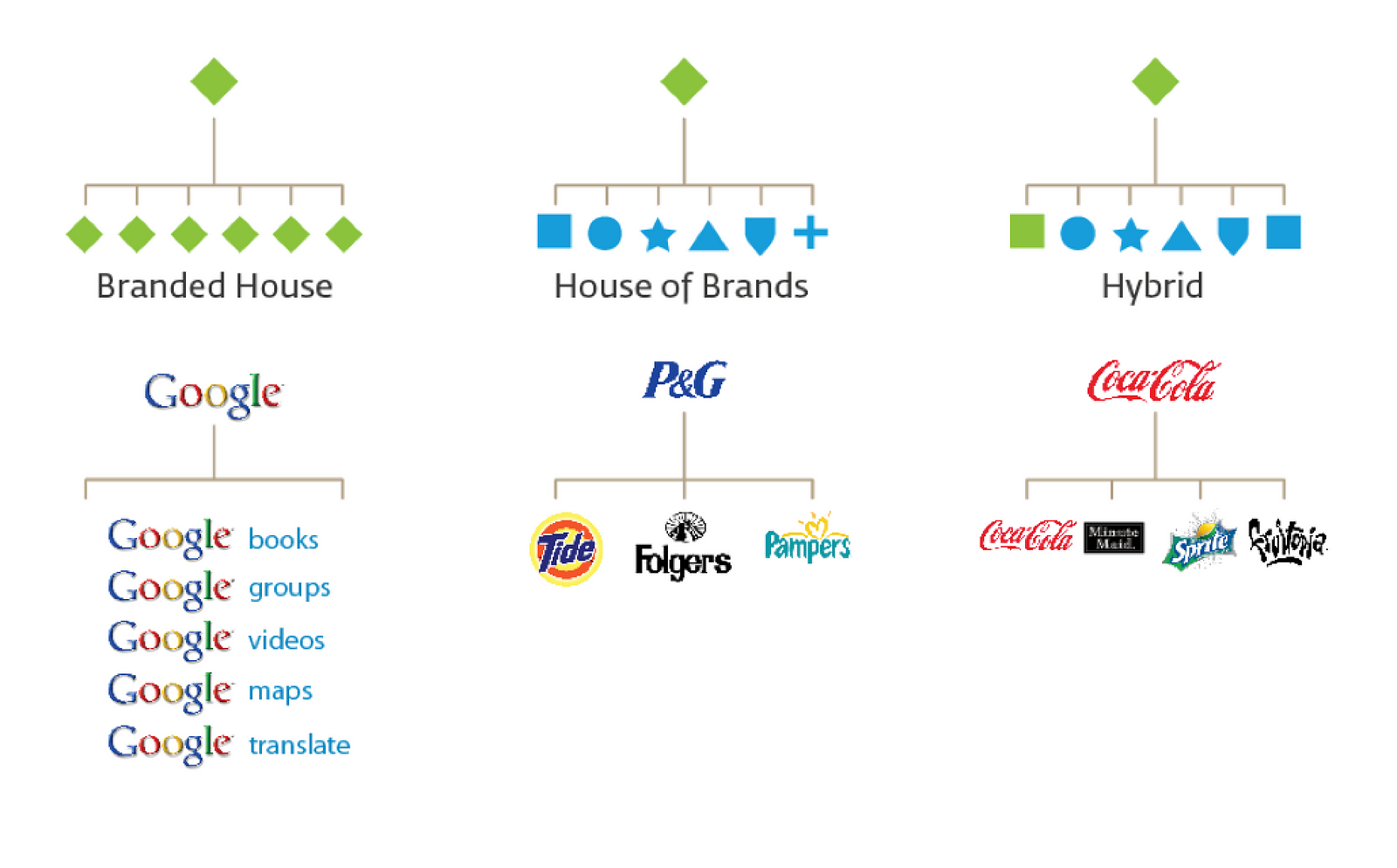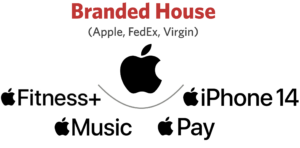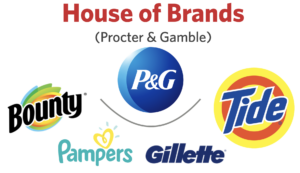When building a strong brand one of the most important strategic decisions is choosing between a house of brands or a branded house structure. But what exactly is the difference and how do you determine which approach is right for your business?
In this comprehensive guide, we’ll examine the unique benefits and characteristics of house of brands versus branded house brand architecture strategies. We’ll look at real examples, pros and cons of each approach, and key factors to consider when deciding between the two models.
Defining House of Brands and Branded House
First. let’s clearly define what we mean by “house of brands” and “branded house”
House of Brands: The parent company owns multiple different brands, each with its own brand identity, name, logo, target audience, positioning, and marketing strategy. The child brands operate fairly independently.
Branded House: The parent company is tied to one master brand. All products and services take on the parent brand name and identity. The focus is on reinforcing the core brand across the portfolio.
Essentially, house of brands provides multiple distinct options for consumers, while a branded house offers different products/services united under one brand identity.
Key Characteristics of House of Brands
Companies utilizing a house of brands approach generally share these traits:
-
Diverse target audiences – Each brand is tailored to specific consumer segments.
-
Separate brand identities – The child brands have their own names, logos, images, and brand personalities.
-
Unique brand equity – Each brand establishes and maintains brand awareness independently.
-
Distinct marketing strategies – Brands operate their own marketing campaigns and positioning.
-
Independent operations – Brand teams have their own business units, management, and bottom lines.
-
Isolated risks – If one brand fails, it has minimal impact on other brands in the house.
This strategy provides flexibility to appeal to broader demographics, take risks, and accommodate acquired brands. However, house of brands require extensive resources to manage multiple unique brands and identities.
Key Characteristics of a Branded House
On the flip side, companies using a branded house approach typically exhibit these attributes:
-
Unified identity – The parent brand name and visual identity unites all products/services.
-
Shared brand equity – New offerings increase the equity and reach of the core brand.
-
Simplicity – Managing one brand with consistent messaging is simpler than juggling many brands.
-
Efficiency – Resources are streamlined under one central brand.
-
Consistency – Offerings align to reinforce the brand’s identity and promise to consumers.
-
Familiarity – Consumers recognize and trust the parent brand across all products.
This strategy maximizes brand visibility and makes introducing new products easier by leveraging existing brand equity. However, it provides less flexibility to target niche audiences or take risks.
Examples of House of Brands Strategy
Some prominent examples of a successful house of brands model:
Procter & Gamble – Owns brands like Tide, Bounty, Pampers, Charmin, Crest, Gillette, and many more, all operating independently.
Unilever – Has over 400 brands including Lipton, Dove, Axe, Hellmann’s, and Ben & Jerry’s, each with unique identities and marketing.
General Mills – Brands such as Cheerios, Pillsbury, Betty Crocker, Häagen-Dazs and Yoplait function as standalone brands under the parent company.
Johnson & Johnson – Operates beloved brands like Band-Aid, Neutrogena, Tylenol, Listerine, Aveeno as separate identities within its house.
This model allows these companies to target specific consumer needs across demographics. If one brand fails, the other brands remain strong.
Examples of Branded House Strategy
Some prominent examples of a successful branded house model:
Apple – All products like iPhone, iPad, Apple Watch, and Mac take on the Apple brand name. This strengthens familiarity and trust in Apple.
Starbucks – Branded house approach with offerings like Starbucks Coffee, Tea, Reserve Roastery all tied to the Starbucks parent brand.
Virgin – Richard Branson’s empire covering Virgin Mobile, Virgin Atlantic, Virgin Hotels, and Virgin Galactic all leverage the Virgin brand equity.
Nike – All products from shoes to apparel carry the Swoosh logo and Nike branding. Brand unity provides consistency.
This strategy allows these companies to efficiently build brand awareness and loyalty across their portfolio of products and services.
Key Pros and Cons of Each Approach
| House of Brands Pros | House of Brands Cons |
|---|---|
| Flexibility to target diverse audiences | Complexity of managing many brands |
| Risk isolation if brands fail | Resource intensive |
| Unique value propositions | Consumer confusion |
| Experiment with brand identities | Potential brand cannibalization |
| Acquire new brands smoothly | Lower brand familiarity |
| Branded House Pros | Branded House Cons |
|---|---|
| Brand recognition and trust | Limiting if you want to target multiple niches |
| Leverage and grow brand equity | Risks tarnishing brand with product failure |
| Cost efficiency of marketing | Dependence on single brand strength |
| Simplicity and consistency | Inflexibility in brand positioning |
| Consumer familiarity across offerings | Constrains brand creativity |
As shown above, each strategy has particular advantages and drawbacks. The right choice depends on your specific business goals and needs.
Factors to Consider When Choosing Between the Models
When determining if a house of brands or branded house is optimal, here are some key considerations:
-
Current brand equity – If you have an established brand with strong equity, a branded house leverages that. A lesser known brand can benefit more from a house structure.
-
Marketing costs – Branded house minimizes marketing costs. House of brands requires greater spend to build awareness for each brand.
-
Target audience – Will you need to appeal to vastly different consumer segments? If so, house of brands allows customization.
-
Category risks – Separating brands insulates risk in higher risk categories like pharmaceuticals.
-
Business model – Will you operate segments as strategic business units? If so, a house model supports that.
-
Future plans – Growth ambitions to expand into new categories or geographies may call for a house of brands approach.
Analyzing these factors specific to your business will guide your brand architecture strategy. Often, the two can be blended into a hybrid model balancing both branded house and house of brands depending on context.
Creating a Hybrid Approach
For some companies, a hybrid model blending house of brands and branded house offers the right balance.
With a hybrid approach, the organizational brand ties together a “house of brands” portfolio. Some brands operate independently, while others take on the parent brand in a branded house structure.
For example, P&G operates largely as a house of brands, but also has branded house extensions like Tide Pods, Pampers Swaddlers, and Crest Whitening Expressions. This provides both flexibility to expand into new categories while also reinforcing select brands.
Finding the right mix depends on your specific business needs. But a hybrid model allows you to leverage the benefits of both brand architecture strategies.
When determining the ideal brand architecture for your company, consider your positioning, audience, risks, plans for the future, and other factors that impact the brand relationship with consumers.
Analyze the unique advantages and limitations of both house of brands and branded house strategies. A hybrid approach can blend these models to meet business needs.
While branded house builds brand familiarity and house of brands provides flexibility, make sure your choice directly maps to your objectives. This central brand strategy decision impacts all aspects of the customer experience.
With these key differences in mind, you can make an informed, strategic decision on the right brand architecture approach to build a strong brand identity and drive growth.

The goal of any brand strategy is to build a strong brand.
That is because a strong brand—and an effective brand strategy—results in a higher return on investment for your marketing dollar. It is as true for professional services brands as it is for consumer products.
Our focus on professional services has informed us of a clear understanding of what makes a strong brand.
Brand Strength = Reputation x Visibility.
Whether developed intentionally or not, every professional services firm has a brand that stands for something. Our research indicates that high-growth professional services brands are more likely to have a strong differentiator – an easy-to-prove and relevant characteristic – as part of their brand strategy. That is because differentiation (or specialization) helps the firm generate leads and improve closing percentages.
As firms grow and mature, the management of their brand strategy can become a challenge. Why?
Because, as collective expertise grows, there is a tendency to diversify the firm’s service offering. To nurture and grow the profitability of those new services, firms often opt to brand each service. But, that might not be the best approach.
When it comes to brand strategy for a growing professional services firm, it may be better to go in the direction of a branded house rather than a house of brands. Let me explain.
Types of brand strategy
In this model, the firm is the brand. Services and market sectors (or practice areas) are subsets of that primary brand and are not formally branded. Apple and Google are globally known for this model. Under Apple’s primary brand comes many subset brands: Mac, Apple Music, and iPhone.

Certainly, even smaller firms can successfully pull off this model. In all instances, the subset brands are recognized, but not to the extent that they overshadow or detract from the primary brand.
In professional services, the branded house approach is also known as a one-firm brand strategy. The firm has a single brand: logo mark, marketplace positioning, and messaging. The subordinate service offerings share these brand elements but contain their own unique messaging points.
In the second brand strategy model, the branding is focused on the subset of brands. The primary brand gets little or no attention. Ever hear of a company called Newell? How about Rubbermaid, Sharpie, or Irwin Tools? Newell is a good example of the house of brands strategy—Newell is the little-known primary brand, under which come the well-known subordinate brands listed above.

A house of brands approach requires significant investment in dedicated resources because each brand operates as its own company in terms of brand elements and messaging.
What Is Brand Architecture (House Of Brands v Branded House Examples)
What is a branded House strategy?
On the flip side, a branded house strategy ensures a strong, unified brand identity. It’s like putting all your eggs in one basket, but with a safety net. This strategy leverages the brand equity of the parent brand, making it easier to launch new products or even new services by springboarding of the pre-existing market reputation.
What is a house of brands?
This House of Brands approach allows Gap Inc. to cater to a wide variety of consumer segments. All its services, like Google Drive, Google Calendar, and Google Docs, share the Google brand, contributing to high visibility and strengthening the parent brand’s reputation.
What is a branded House?
On the other hand, a branded house is more like a single-child family. In this case, the parent company is the main brand, and all its products endorsed brands or services carry its name. This approach allows the brand equity of the parent brand to extend to all the sub-brands or new products. Why Is A House Of Brands Important?
What are some examples of branded Houses?
Examples of companies using this framework include HSBC and Virgin. Amazon is also predominantly a branded house as most of its new products derive their strength from the mother brand. A company that recently changed the brand architecture of its flagship brand, moving it closer to a branded house is Coca-Cola.